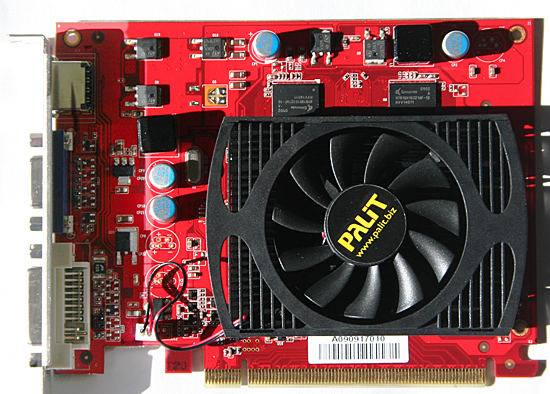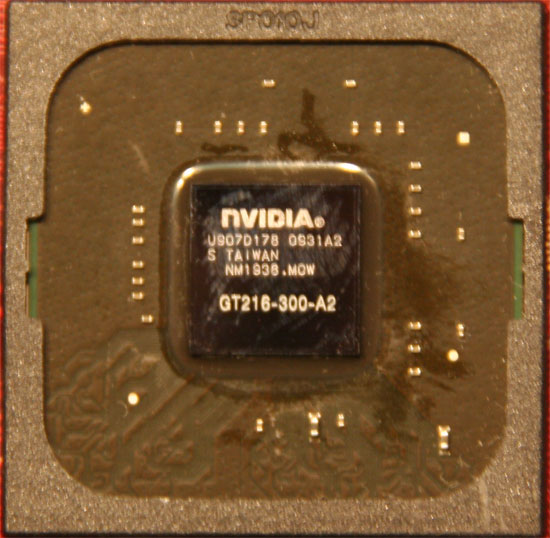NVIDIA’s GeForce GT 220: 40nm and DX10.1 for the Low-End
by Ryan Smith on October 12, 2009 6:00 AM EST- Posted in
- GPUs
There are some things you just don’t talk about among polite company. Politics, money, and apparently OEM-only GPUs. Back in July NVIDIA launched their first 40nm GPUs, and their first GPUs featuring DX10.1 support; these were the GeForce GT 220 and G 210. And if you blinked, you probably missed it. As OEM-only parts, these went into the OEM channel without any fanfare or pageantry.
Today that changes. NVIDIA is moving the GT 220 and G 210 from OEM-only sales to retail, which means NVIDIA’s retail vendors can finally get in on the act and begin selling cards. Today we are looking at one of the first of those cards, the Palit GT 220 Sonic Edition.
| Form Factor | 9600GT | 9600GSO | GT 220 (GDDR3) | 9500GT | G 210 (DDR2) |
| Stream Processors | 64 | 48 | 48 | 32 | 16 |
| Texture Address / Filtering | 32 / 32 | 24 / 24 | 16 / 16 | 16 / 16 | 16 / 16 |
| ROPs | 16 | 16 | 8 | 8 | 8 |
| Core Clock | 650MHz | 600MHz | 625MHz | 550MHz | 675MHz |
| Shader Clock | 1625MHz | 1500MHz | 1360MHz | 1400MHz | 1450MHz |
| Memory Clock | 900MHz | 900MHz | 900MHz | 400MHz |
400MHz |
| Memory Bus Width | 256-bit | 128-bit | 128-bit | 128-bit | 64-bit |
| Frame Buffer | 512MB | 512MB | 512MB | 512MB | 512MB |
| Transistor Count | 505M | 505M | 486M | 314M | 260M |
| Manufacturing Process | TSMC 55nm | TSMC 55nm | TSMC 40nm | TSMC 55nm | TSMC 40nm |
| Price Point | $69-$85 | $40-$60 | $69-$79 | $45-$60 | $40-$50 |
GT 220 and G 210 are based on the GT216 and GT218 cores respectively (anyone confused yet?) which are the first and so far only 40nm members of NVIDIA’s GT200 family. These are specifically designed as low-end cards, with 48 SPs on the GT 220, and 16 SPs on the G 210. The GT 220 is designed to sit between the 9500GT and 9600GT in performance, making its closest competitor the 48SP 9600GSO. Meanwhile the G 210 is the replacement for the 9400GT.
We will see multiple configurations for each card, as NVIDIA handles low-end parts somewhat looser than they do the high-end parts. GT 220 will come with DDR2, DDR3, or GDDR3 memory on a 128bit bus, with 512MB or 1GB of it. So the memory bandwidth of these cards is going to vary wildly; the DDR2 cards will be 400MHz and the GDDR3 cards may go as high as 1012MHz according to NVIDIA’s specs. G 210 meanwhile will be DDR2 and DDR3 only, again going up to 1GB. With a 64bit memory bus, it will have half the memory bandwidth of GT 220.

The GPU configurations will vary too, but not as wildly. NVIDIA’s official specs call for a 625MHz core clock and a 1360MHz shader clock. We’ve seen a number of cards with a higher core clock, and a card with a lower shader clock. Based on the card we have, we’re going to consider 635Mhz/1360Mhz stock for the GPU, and 900MHz stock for GDDR3, and test accordingly.
The transistor count for the GT218 die comes out to 260M, and for GT216 it’s 486M. NVIDIA would not disclose the die size to us, but having disassembled our GT 220, we estimate it to be around 100mm2. One thing we do know for sure is that along with the small die, NVIDIA has managed to knock down power consumption for the GT 220. At load the card will draw 58W, at idle it’s a tiny 7W. We don’t have the power data for the G 210, but it’s undoubtedly lower.

The prices on GT 220 cards are expected to range between $69 and $79, with the cards at the top end being those with the best RAM. This puts GT 220 in competition with AMD’s Radeon HD 4600 series, and NVIDIA’s own 9600GT. The G 210 will have an approximate price of $45, putting it in range of the Radeon HD 4300/4500 series, and NVIDIA’s 9500GT. The GT 220 in particular is in an odd spot: it’s supposed to underperform the equally priced (if not slightly cheaper) 9600GT. Meanwhile the G210 is supposed to underperform the 9500GT, which is also available for $45. So NVIDIA is already starting off on the wrong foot here.
Finally, availability should not be an issue. These cards have been shipping for months to OEMs, so the only thing that has really changed is that now some of them are going into the retail pool. It’s a hard launch and then some. Not that you’ll see NVIDIA celebrating; while the OEM-only launch was no-key, this launch is only low-key at best. NVIDIA didn’t send out any samples, and it wasn’t until a few days ago that we had the full technical data on these new cards.
We would like to thank Palit for providing us with a GT 220 card for today’s launch, supplying us with their GT 220 Sonic Edition.










80 Comments
View All Comments
chizow - Monday, October 12, 2009 - link
Of course, discerning consumers know better and demand new architectures! It wouldn't make any sense to accept old parts and rebadges that offer 2x the performance at a lower price!yacoub - Monday, October 12, 2009 - link
er, 8800GT. fingers...poohbear - Monday, October 12, 2009 - link
man i never thought i'd be saying this, but nvidia needs to get their shiat together!!! we need competition!!! they're getting trashed by AMD, what happened to em?Souleet - Monday, October 12, 2009 - link
Everybody know NVIDIA is downplaying until they see how well Window 7 will be. Plus ATI releasing 5800 series with DX.11(software/games not going to be compatible with it until 2011).formulav8 - Monday, October 12, 2009 - link
Huh? The new Radeons are compatible with every game the old radeons and geforce cards are and much better/faster.And there is a small list of games with DX11 features being released very soon that ONLY the new radeons can take advantage of.
And nVdia isn't downplaying anything. They simply DO NOT have a answer to ATI's new cards at this time. And apprently it won't be till the first part of next year that they will have their answer.
Why I keep seeing people trying to downplay nvidia's faults is beyond me?
Jason
Souleet - Monday, October 12, 2009 - link
Well I guess we have to wait and see. You cannot assume they do not have the answer. It is not the right time to release something at the caliber yet. I'm not bias but it seem that people are saying that ATI have won but there is no facts/comparison. Sure you can compare ATI 5800 series to the GT295/275(old graphic) but I think everybody want to see GT300 series face off with 5800 series. Remember what happen to ATI when NVIDIA came out with SLI? ATI release crossfire(not innovated) just to try and match NVIDIA instead of creating something more innovated. ATI never had a solution to defeat SLI and that is the fact.JarredWalton - Monday, October 12, 2009 - link
I wouldn't say ATI has "won", but they are currently leading. NVIDIA isn't releasing Fermi right now because they can't -- they don't have the hardware ready. The card shown was a mock-up part, and you don't use a fake card if you have real product ready. All signs are Jan/Feb 2010 for the GT300 release. That gives ATI a full four months of being the ONLY DX11 GPU supplier, right at a major buying time for consumers. NVIDIA isn't out by any stretch of the imagination -- just as ATI wasn't out with the 2000 and 3000 series, and NVIDIA weathered the FX 5000 times. Short-term, though, this has to be hurting.On the other hand, I can say that NVIDIA is the way to go on virtually any gaming laptop right now. ATI has some competitive parts, yes, but I wouldn't touch them until they get reference drivers for all major parts on their site. Depending on laptop manufacturers for driver updates is a really bad idea, and NVIDIA thankfully addressed that area a while back.
brybir - Monday, October 12, 2009 - link
Your statement is only partially true.There are several games that have some DirectX 11 features out right now. Perhaps the more accurate thing to say is that DirectX 11 will not see feature set adoption en mass until sometime in 2011.
I think ATI somewhat admits this as they spent a good deal of time tweaking some of its driver and hardware features to boost the performance of directX 9 engine games. There was something about that on Anand a few weeks ago about that.
BenSkywalker - Monday, October 12, 2009 - link
You show the 9600GSO winning the majority of the benches you decided to allow it to take part in, it is cheaper then the 4670, and the 4670 is the clear winner?Why do you bother quoting the price of the 9600GT when you refused to show benchmarks for it?
Right now on the Egg you can get a 9600GSO for $40 AR, $60 before rebate. The article may be right in terms of the parts that are launching being a bad value, but more then anything that is because of how soundly they are bested by nV's existing parts- which are already faster and cheaper then the 4670.
Ryan Smith - Monday, October 12, 2009 - link
It's one of those 96SP GSOs based on G92. We include for reference only; you can't buy them any more (and the 96SP model listed on Newegg is wrong, it's a 48SP model).